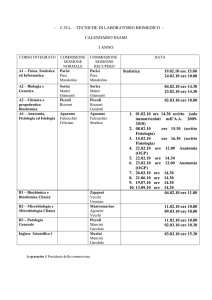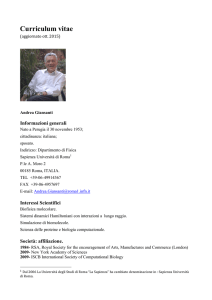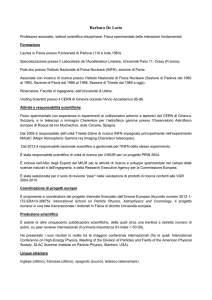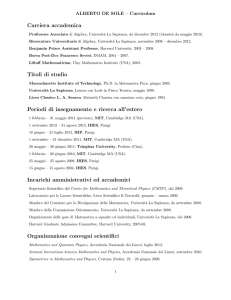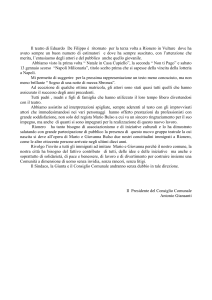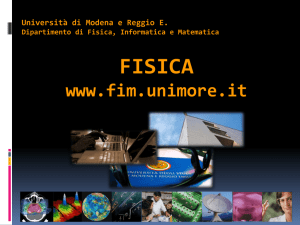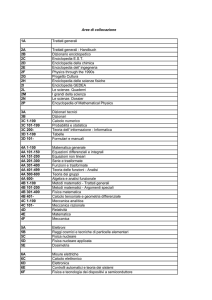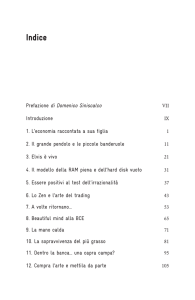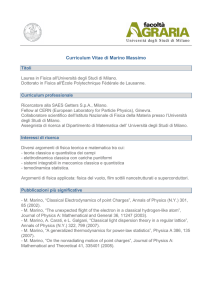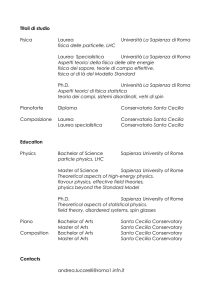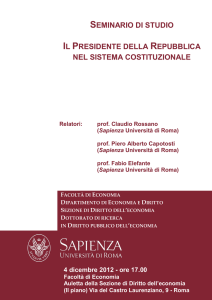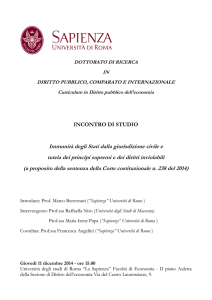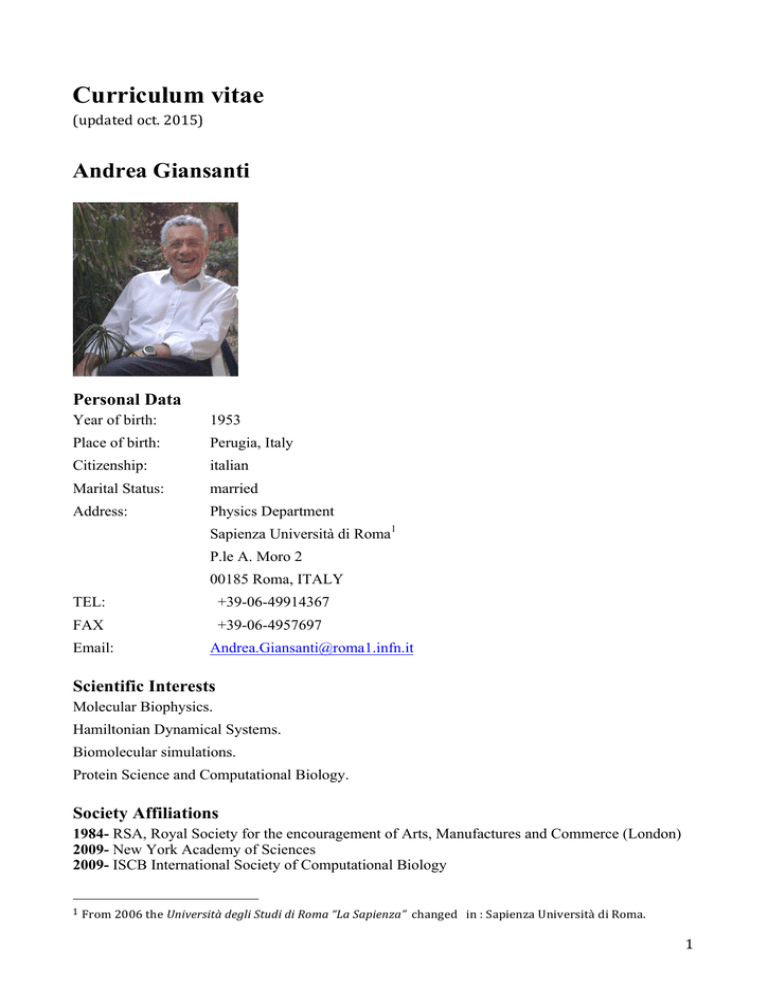
Curriculum vitae
(updatedoct.2015)
Andrea Giansanti
Personal Data
Year of birth:
1953
Place of birth:
Perugia, Italy
Citizenship:
italian
Marital Status:
married
Address:
Physics Department
Sapienza Università di Roma1
P.le A. Moro 2
00185 Roma, ITALY
TEL:
+39-06-49914367
FAX
+39-06-4957697
Email:
[email protected]
Scientific Interests
Molecular Biophysics.
Hamiltonian Dynamical Systems.
Biomolecular simulations.
Protein Science and Computational Biology.
Society Affiliations
1984- RSA, Royal Society for the encouragement of Arts, Manufactures and Commerce (London)
2009- New York Academy of Sciences
2009- ISCB International Society of Computational Biology
1From2006theUniversitàdegliStudidiRoma“LaSapienza”changedin:SapienzaUniversitàdiRoma.
1
Education
1972 Diploma di maturità classica, Liceo-Ginnasio “A. Mariotti”, Perugia, Italy. With full marks.
1977 Laurea in Fisica, Università degli Studi di Roma ”La Sapienza”, Roma, Italy. Thesis:
“Infrared and gravimetric study of lysozyme” (supervisor: prof. G. Careri). Summa cum laude.
Scholarships
1972-77 Student in residence, Collegio Universitario “Lamaro-Pozzani”
, Federazione Nazionale Cavalieri del Lavoro, Rome, Italy.
1978 Foundation Blanceflor Boncompagni-Ludovisi née Bildt (Rome-Stockholm). Scholarship to
do research in molecular biophysics: Physics Department UIUC, Champaign-Urbana ILL, USA.
1979 CNR, Consiglio Nazionale delle Ricerche. Scholarship to do research on biological matter:
Physics Department, Università degli Studi di Roma “La Sapienza”, Rome, Italy
Employment
1981- Ricercatore confermato (Senior Research Fellow); Dipartimento di Fisica, Università degli
Studi di Roma “La Sapienza”, Rome, Italy.
1978-79. Post-doc research associate; Physics Department, University of Illinois at UrbanaChampaign IL, USA; host: prof. E. Gratton.
1983. Visiting Scientist; Dipartimento di Fisica, Università degli Studi di Trento, Trento, Italy; host:
prof. G. Jacucci.
1984. Visiting scientist; Biology Department, Mount Allison University, Sackville N.B., Canada;
host: prof. D. S. Fensom.
1985-86. Guest Investigator; Theoretical Physics Department, The Rockefeller University, New
York NY, USA; host: prof. N. N. Khuri.
1993-94. Visiting scientist; CECAM, Centre Européen de Calcul Atomique et Moléculaire, Orsay
and Lyon, France; host: prof. G. Ciccotti.
2004. Visiting scientist; Dipartimento di Fisica e Astrofisica, Università degli Studi di Catania and
Scuola Superiore di Catania; hosts: profs. A. Rapisarda and V. Latora.
2009- Research Associate, INFN Istituto Nazionale di Fisica Nucleare, CS IV, Res. Unit Rome1,
local coordinator of the research project MI41, then renamed DYNSYSMATH.
2013-2019 MIUR (Italian Ministry of Education Universities and Research) National Academic
Qualification as Associate Professor; sect. 02/B3 (applied physics) [personal id. 76352].
Teaching and Services to Sapienza University of Rome
1987-90. Executive committee, Physics Department.
1990-98. Graduate Committee, Advanced School of Medical Physics.
1992-1996. Scientific Curator of the Library, Physics Department.
1999- Graduate Committee, School of Biophysics.
2003- Coordinator of the course: Physics, Statistics, Informatics, School of Occupational Therapy
2007- 2014 Scientific Committee, CISB Interdepartmental Research Centre for Models and
Information Analysis in Biomedical Systems.
2008- Departmental coordinator, ERASMUS Exchange Program.
2
2010- Departmental committee, ERASMUS MUNDUS AtoSim Master Course.
2015- Erasmus Academic Coordinator, Faculty of Sciences.
Teaching: Undergraduate courses.
1978-98. Various teaching assistantships, seminars and classes: Condensed Matter, General physics
and experiments, General Physics Laboratory, Biophysics and Molecular Physics. Physics
Department.
1996-2000. Course of General Physics Laboratory, School of Biology.
1990-98. Course of Physics Complements, Advanced School of Medical Physics.
2000-2003. Course of General Physics, School of Pharmacy.
2003- Physics, School of Occupational Therapy.
2005- 2010 Course of Computational Biophysics, Master course in Physics.
2009- 2012 Course of Basic Biophysics, Physics Department.
2012- Course of Biophysics II, Master course in Physics.
Graduate Courses
2010- Biological Data Mining. “Vito Volterra” Graduate School.
Laurea theses advisees.
1. Marco Geraci, Physics, 1984. Studi dielettrici e gravimetrici dell' idratazione del lisozima.
(Dielctric-gravimetric studies of lysozyme) Co-advisor: Giorgio Careri.
2. Alessandro Campa, Physics, 1985. Transizione caos-ordine nel cristallo di acetanilide con il
metodo della dinamica molecolare (Chaos-order transition in the acetanilide crystal: a
molecular dynamics study). Co-advisor: Alexander Tenenbaum.
3. Antonella Pavone, Physics, 1995. Tecniche laser per la realizzazione di dispositivi
bioelettronici (Laser techniques in bioelectronics) Co-advisor: Piero Morales, at ENEA
Casaccia.
4. Livia Aromatario, Physics, 1996. Transizione stocastica e transizione vetrosa in miscele
binarie di Lennard-Jones (Chaos-order and glass transitions in binary LJ mixtures).
5. Vito Servedio, Physics, 1996. Soluzione su reticolo dell' equazione di Poisson -Boltzmann
linearizzata con permettività variabile spazialmente. Applicazione al calcolo del potenziale
elettrico di una proteina (Lattice solutions of the linearized PB equation with nonhomogeneous dielectric permittivity. Electric potentials in proteins).
6. Flaminia Malvezzi Campeggi, Physics, 1997. Effetto dell' alta pressione e dei denaturanti
chimici sulla struttura e sulla stabilità delle proteine (High pressure and denaturants’ effects
on proteins). Co-advisor: Nicola Rosato, Dept. Experimental Medicine and Surgery,
Università di Roma 2 ”Tor Vergata”.
7. Antonella Luise, Physics, 1998. Studio dell' idratazione dell' azzurrina con la dinamica
molecolare (The hydration of azurin: a molecular dynamics study) Co-advisor: Alessandro
Desideri, Biology Dept., Università di Roma 2 “Tor Vergata”.
8. Andrea De Martino, Physics, 1998. Transizione percolativa e mancanza di automedia in un
modello estremale (Percolative transition and lack of self-averaging in an extremal model).
9. Marco Punta, Physics, 1998. Cooperazione, Complessità e caos nel modello di PeyrardBishop (Cooperativity, Complexity and Chaos in the Peyrard-Bishop Model of DNA).
10. Daniele Moroni, Physics, 1999. Dinamica e termodinamica di un modello XY con lunghezza
di interazione variabile (Dynamics and Thermodynamics of an XY model with variable range
interactions).
11. Luca Ferraro, Physics, 2002. Riconoscimento e Analisi delle Sequenze Peptidiche nei
3
Proteomi degli Archea, Batteri ed Eucarioti (Recognition and analysys of linear peptide
motifs in the proteomes of Bacteria, Archaea and Eukarya). Co-advisor: Vittorio Rosato, at
ENEA-Casaccia.
12. Paolo Calligari, Physics, 2004. Sequenze, matrici binarie e folding delle proteine (Sequences,
binary matrices and protein folding).
13. Alessandra Traini, Physics, 2004. Costruzione di alberi filogenetici da interi proteomi: il
ruolo delle sequenze a bassa complessità (Inferring philogentic trees from whole proteomes:
role of low-complexity sequences).
14. Carlotta Martelli, Physics, 2004. Il ruolo della topologia sul comportamento dinamico di una
rete di reazioni di attivazione-disattivazione (Topology and dynamics of a network of
activation-deactivation biochemical reactions). Co-advisor: Vittorio Rosato, at ENEACasaccia.
15. Uri Baranes, Biology, 2005. Il bromodominio: un dominio presente in tutti gli eucarioti.
Analisi in silico (In silico, phylogenetic analysis of bromodomains from eukaryots). Coadvisor: Paola Ballario, Biology and Biotechnology Dept. Sapienza University of Rome.
16. Gianluca Morelli, Physics, 2005. Stati quasi-stazionari nel modello Hamiltonian mean field
(Quasi-stationary states of the Hamiltonian mean-field model).
17. Maria Teresa Azzollini, Physics, 2005. Dinamica molecolare di modelli di proteine ottenuti
per omologia di sequenza (Comparative Molecular Dynamics of protein structures inferred
via homological methods ).
18. Antonio Deiana, Physics, 2006. Riconoscimento e classificazione di proteine strutturate.
Segnali di sequenza e reti (Recognition and classification of protein structures from sequences
and intraresidue inferred networks).
Dissertation advisees (B.A. Course)
1. Fabio Ricci, Università degli Studi di Pisa, 2004. Simulazione Numerica di Sistemi
Molecolari con Interazioni a Lungo Raggio: condizioni al contorno periodiche e sferiche
(Numerical Simulation of Molecular Systems with Long-Range Interactions: periodic and
Spherical Boundary conditions). Co-advisor: Dino Leporini.
2. Fabio Perroni, Fisica-Sapienza, 2006. La distribuzione della prima cifra significativa (The
distribution of the first significant digits: Benford’s law.).
3. Eleonora Stefanutti, Fisica-Sapienza, 2008. Teoria quantistica della struttura molecolare
(Quantum theory of molecular structure).
4. Francesca Amaduzzi, Fisica-Sapienza, 2008. Quantizzazione del flusso magnetico nei
superconduttori (Quantization of Magnetic Flux in Superconductors).
5. Francesco Scarlatti, Fisica-Sapienza, 2009. Il teorema adiabatico nella meccanica
quantistica (The Adiabatic Theorem in Quantum Mechanics).
6. Alessandro Tomarchio, Fisica-Sapienza, 2009. Quantizzazione del flusso magnetico nei
superconduttori (Quantization of Magnetic Flux in Superconductors).
7. Marco Magliocchetti, Fisica-Sapienza, 2009. Riconoscimento dei siti funzionali del DNA
tramite la dinamica del modello di Peyrard-Bishop (Recognitiion of functional sites along
DNA, via the dynamics of the Peyrard-Bishop Model).
8. Duccio Piovani, Fisica-Sapienza, 2009. Analisi spettrale di matrici di correlazione di
multiallineamenti di protein (Spectral analysis of covariance matrices from multiplealignments of protein sequences). Co-advisor: Andrea De Martino.
9. Alfredo Iacoangeli, Fisica-Sapienza, 2010. Quantizzazione del flusso magnetico nei
superconduttori non semplicemente connessi (Quantization of Magnetic Flux in
Superconductors).
10. Maddalena Di Lucca, Fisica-Sapienza, 2010. Meccanica statistica di un oggetto
matematicamente rotto in progressione geometrica (Statistical Mechanics of the
“Geometrically Broken Object”).
11. Valerio Ciotti, Fisica-Sapienza, 2010. Spettroscopia Raman e statistica dei nuclei (Nuclear
4
Statistics and Raman Spectroscopy).
12. Laura Carlini, Fisica-Sapienza, 2011. Il teorema del viriale in meccanica classica e
quantistica (The Virial Theorem in Classical and Quantum Mechanics).
13. Gianluca Dezi, Fisica-Sapienza, 2012. I lavori di Franco Rasetti sulla spettroscopia Raman
di molecole biatomiche omonucleari (1928-1930) (Franco Rasetti’s papers on the Raman
specra of diatomic molecules).
14. Andrea Auconi, Fisica-Sapienza, 2012. Predizione di struttura secondaria di RNA (On RNA
secondary structure prediction).
15. Leone Di Mauro, Fisica-Sapienza 2013. Misure della costante di gravitazione universal (
Measurements of the Gravitational Constant).
16. Annalisa Bucci, Fisica-Sapienza 2014. Fluidi di Van der Waals (Van der Waals Fluids).
17. Andrea Ciardiello, Fisica-Sapienza 2014. Quantizzazione del flusso nei superconduttori
(Quantization of Magnetic Flux in Superconductors).
Master theses advisees.
1. Erika Nori, Physics, 2007. Geometria interna di strutture proteiche e omologia (Internal
Geometry of Protein Structures and Homology).
2. Daniele Granata, Physics, 2008. Stati ottimali del metabolismo dei globuli rossi (Optimal
states of erythrocyte metabolism). Co-advisor: Andrea De Martino.
3. Giulio Cimini, Physics, 2008. Analisi statistica di livelli di espressione di probes genici
(Statistical analysis of gene probes expression levels). Co-advisor: AndreaDe Martino.
4. Marco Di Stefano, Physics, 2010. Studio della Struttura Dinamica del Sito Attivo di
Neuraminidasi Virali tramite il Modello Gaussiano-β (Structural Dynamics of Viral
Neuraminidases based on the Gaussian- βmodel).
5. Ermias Libendingel Tsege, Physics (Erasmus Mundus AtoSim Master Student), 2010. SolidLiquid Transition and the Transition to Chaos in 3D Lennard-Jones Systems.
6. Paolo Mariani, Physics, 2010. Transizioni di fase e transizioni stocastiche in sistemi finiti
con interazioni a corto e a lungo raggio (Phase transitions and stochastic transitions in finite
systems with both long- and short-range interactions).
7. Ramin Ghorbani (AtoSim Erasmus Mundus student, Fisica-Sapienza), 2011. Caloric curves
and dynamical phase transitions in finite systems.
8. Emanuele Raccah, Fisica-Sapienza, 2012. Applicazione delle tecniche del gruppo di
rinormalizzazione alle cinetiche enzimatiche (Renormalization group techniques and
enzymatic kinetics).Co-advisor: Alberto Bersani. Dept. of Basic and Applied Sciences for
Engineering, Sapienza University of Rome.
9. Andrea Semmoloni, Fisica-Sapienza, 2013. Codon-bias and E.coli interactome.
10. Andrea Auconi, Fisica-Sapienza, 2015. Dinamica stocastica dell’ interazione recettoreligando (Stochastic Dynamics of the receptor-ligand interaction).
PhD theses advisees
1. Francesco Pizzitutti, 2004. Exploring protein functionality by in silico experiments.
Graduate school of Biophysics, XVI course, Università degli Studi di Roma “La Sapienza”.
2. Carlotta Martelli, 2009. Understanding metabolic networks from a global optimization
principle. Graduate school of Biophysics, XXI course, Sapienza Università di Roma (coadvisor: Andrea De Martino.
3. Antonio Deiana, 2011. Structural Disorder In Proteins: from amino acid composition to
mechanical stability. Graduate school of Biophysics, XXII course, Sapienza Università di
Roma.
4. Lucia Di Giambattista, 2011. Therapeutic Ultrasound-Mediated Bioeffects in a cell line: A
contribution to optimize the intracellular delivery of drugs and genes. Graduate school of
Biophysics, XXII course, Sapienza Università di Roma.
5. Erika Nori, 2012. Structural classification of proteins based on a synthetic geometric
5
representation. Graduate school of Biophysics, XXIV course.
6. Daniele Bovi, 2013. Ab-initio molecular dynamics studies in the molecular biophysics
of photosynthesis. Graduate school of Biophysics, XXV course (co-advisor, Leonardo
Guidoni).
Professional Duties
International
• Discussion meeting: Static and Dynamic properties of systems with long-range interactions.
La Sapienza Università di Roma, 17 May 2001.
• Workshop: Single molecule studies: from the experiments to their analysis , co-organized
with: M. Buiatti, A. Campa, M. Peyrard and S. Ruffo, Lyon, Ecole Normale Supérieure CECAM (Centre Européen de Calcul Atomique et Moleculaire), 24-26 Sep. 2001.
• Workshop: From DNA sequence to function, co-organized with: M. Buiatti, A. Campa, M.
Peyrard and S. Ruffo, Lyon, Ecole Normale Supérieure - CECAM (Centre Européen de
Calcul Atomique et Moleculaire), 26-28 Sep. 2001.
• International Conference: Dynamics and thermodynamics of systems with long-range
interactions: theory and experiments, principal organizer, co-organized with: A. Campa, A.
Giansanti, G. Morigi and F. Sylos Labini. Assisi, 4-8 Jul. 2007 (Satellite of Statphys 23).
National
• Co-organizer of the biennial meeting: “Acta Biophysica Romana”, various sessions:
Università di Roma “La Sapienza”, 1997; Università di Roma “Tor Vergata”, 1999;
Università Cattolica del Sacro Cuore, Roma, 2001; Università degli Studi di Roma “La
Sapienza”, 2004; Università degli Studi di Roma “Tor Vergata”, 2006; Università degli
Studi di Roma Tre , 2008.
• Local Scientific coordinator of the national project: “Fisica statistica di sistemi con
interazione a lungo raggio: studi analitici e numerici, dalla materia condensata alle
strutture cosmologiche”. MIUR-PRIN 2005, “Dinamica e termodinamica di sistemi con
interazione a lungo raggio”, coord: Prof. S. Ruffo.
Advisory activities
Consulting Contract: Ridefinizione della metodologia di valutazione dell’ indice diagnostico
denominato CV (Chimec Value). CHIMEC S. p. A., Roma, Italy. 2004-2005.
Referee for:
Advances in Complex Systems
AJP- Regulatory, Integrative and Comparative Physiology
Biophysical Journal
Biophysical Chemistry
Central European Journal of Physics
Physical Review E
6
Physical Review Letters
Invited seminars and talks
International
1. Codon bias and E.coli’s protein-protein interaction network. CNISM Meeting FisMat2015,
Palermo 29 sett. 2015.
2. Disordered proteins: perspectives on a few dogmas: water sorption isotherms and
intrinsically disordered proteins. CECAM-IRL workshop: Advanced Simulation/Modelling
in Food., University College Dublin, EI, December 4-5, 2014.
3. How to detect a twilight zone between order and disorder in the Protein Data Bank.
CECAM workshop: Linking Systems Biology and Biomolecular Simulations. Lausanne,
SW, 16-19 Nov. 2009.
4. Remarks on Condorcet’s paradox.
CTNEXT2007, Complexity, metastability and
nonextensivity, Catania, Italy, 1-5 Jul. 2007.
5. Inner Hydrophobicity Networks. Complex Networks in Biology and Engineering: from
principles to applications. Tel Aviv, IL, 23-27 Oct. 2007.
6. Evolution and dynamics of bromodomains: looking for a dynamical disegnability. OsakaRome workshop, Sapienza Università di Roma, Italy. 5-6 Mar. 2007.
7. Co-expression of Statistically Over-represented Motifs in Proteomes: a way to reconstruct
Phylogenies from Whole genomes. Trinity College, Dublin, EI, 24 Nov. 2004.
8. Sequence and dynamics in protein-protein interaction modules. Workshop and Europhysics
Conference “Structure and Function of Biomolecules” Bedlewo, Poland, 13-15 May 2004.
9. Protein sequences/dynamics/function, Coordination Meeting of the Network of Excellence:
“Proteomics: a dynamical approach”, Florence, Italy, 4-5 Nov. 2002.
10. On the meta stable states of the α-XY model. Workshop and School: “Dynamics and
thermodynamics of systems with long range interactions”, Les Houches, France, 18-22 Feb.
2002.
11. Local torsional elasticity of DNA oligomers of prescribed sequence: experimental data and
coarse-grained molecular modeling. CECAM Workshop “Single molecule studies: from the
experiments to their analysis”, Lyon, ENS, France, 24-28 Sep. 2001.
12. Universal behavior in the thermal and chaotic properties of the α-XY model. International
School and Workshop on Non Extensive Thermodynamics and Physical Applications”,
Villasimius (Cagliari), Italy 23-30 May 2001.
13. On the limits of full rational management. Master in “National and Supranational
Management”, ISUFI, Lecce, Italy, 21-23 Apr. 2001.
14. Chaos in the α-XY model, HMF Meeting, Dipartimento di Fisica ed Astronomia, Università
di Catania, Catania, Italy, 6-8 Sep. 2000.
15. Dynamics and thermodynamics of the α-XY model in two and three dimensions. Workshop:
Classical and Quantum Complexity and Nonextensive Thermodynamics. University of
North Texas, Denton, TX USA, 3-6 Apr. 2000.
16. Towards a Biology of Protons. Talk at the International Center for Theoretical Physics
(ICTP) Trieste, Italy, 15 Sep. 1999.
7
17. Echo effects in nonlinear chains of oscillators. Workshop: "Statistical Methods in Space Time Chaos”, Forum di Fisica Teorica della Materia - Scuola Normale Superiore
PISA(SNS). Firenze, Italy, 3-5 Oct . 1994.
18. Temperature echoes and thermal relaxation of single modes. CECAM Workshop: "Chaotic
and ordered energy flow in lattices". Lyon, France, 29 Aug.- 9 Sep. 1994.
19. Thermophiles vs. Eubacteria: Physical Differences in Ribosomal Subunits. Discussion
Meeting: "Structure-Dynamics-Function relationship in Molecular and Supramolecular
structures from Thermophilic archeobacteria". INFM-Sezione Biofisica. Ancona, Italy, 9-11
May 1993.
20. Hamiltonian chaos and protein dynamics. Mini-workshop: "Linear chains and
macromolecules". Dipartimento di Fisica, La Sapienza, Roma, Italy. 6 May 1993.
21. Protonic conductivity in biomaterials in the frame of percolation model. NATO Advanced
Research Workshop: "Biologically Inspired Physics". Cargèse, France, 3-13 Sep. 1990.
22. Vibrational Properties and Energy Transport in Acetanilide by Molecular Dynamics. NATO
Advanced Research Workshop: "Self-trapping of Vibrational Energy in Protein". Thisted,
Denmark, 30 Jul. – 5 Aug.1989.
23. The onset of dynamical chaos in topological massive gauge theories. Meeting: "Nonlinear
Dynamics". Dipartimento di Matematica, La Sapienza, Roma, Italy. 27-29 Oct. 1986.
National
Epistemologia comparata delle scienze fisiche e mentali. Master internazionale di
secondolivelloinPsicoterapiaCognitivaPostrazionalista,Roma18aprile2015 Master
in Psicoterapia Cognitivista Costruttivista e Postrazionalista, Sapienza Università di
Roma,Roma,18aprile2015.
2. On the abundance of intrinsically disordered proteins in the human proteome and its
relation to diseases. The CISB scientific activity: recent and seminal achievements.
Sapienza Università di Roma, Pal. Baleani, Roma 29 Mag. 2014.
1.
3. Codon bias: segnale o rumore? Dottorato di Ricerca in Scienze Morfofunzionali. Sapienza
Università di Roma, 11 Nov. 2013.
4. Introduzione all’ analisi bayesiana dei dati, Dottorato di Ricerca in Biofisica. CISB,
Sapienza Università di Roma, 25 Mar. 2009.
5. Dai sistemi di rotatori accoppiati ai nuotatori a bassi numeri di Reynolds, Dipartimento di
Fisica, La Sapienza Università di Roma, 19 Mar. 2009.
6. Reti interne di idrofobicità in proteine, Dottorato di Ricerca in Biofisica, La Sapienza
Università di Roma. 11 Giu. 2008.
7. Teoria elementare della probabilità. Ciclo di lezioni, Dottorato di Ricerca ISUFI in “Diritto
dell’ Economia e del Mercato”, Università degli Studi di Lecce, Dic.2007-Feb. 2008. In
collaborazione con A. De Martino.
8. Fisica e diritto: progetti sulla natura e sull’ umanità. Dottorato di Ricerca ISUFI in “Diritto
dell’ Economia e del Mercato”, Università degli Studi di Lecce, 4 Giu. 2007.
9. Epistemologia: Fisica/Mente. Scuola di specializzazione in psichiatria, 1a Facoltà di
Medicina e Chirurgia, Sapienza Università di Roma, 16 Dic. 2006
10. Dinamica molecolare evolutiva dei bromodomini. Workshop Metodi teorici in Biologia,
Dipartimento di Matematica, Università degli Studi di Milano, 31 Gen. 2006.
8
11. Metodo galileiano e complessità . Convegno: “Il cognitivismo sistemico post-razionalista
nel dibattito scientifico e nella pratica clinica”, Dipartimento di Scienze Neurologiche e
Cliniche, Università degli Studi di Roma “La Sapienza”, 20 Giu. 2005.
12. Osservazioni su “La Forma del Tempo” di G. Kubler. Istituto Centrale per il Restauro,
Roma, 3 Mag. 2005.
13. Matrice di Co-espressione di motivi linguistici e filogenesi di interi proteomi. Dipartimento
di Fisica e Astronomia Università degli Studi di Catania, 19 Ott. 2004.
14. Concetti, temi e idee sulla complessità. Scuola Superiore di Catania, 7 Ott. 2004.
15. Matrice di Co-espressione di motivi linguistici e filogenesi di interi proteomi. Dipartimento
di Biologia, Università di Roma Tor Vergata. 24 Set. 2004.
16. Metodo galileiano e sistemi complessi. Scuola di specializzazione in psichiatria, 1a Facoltà
di Medicina e Chirurgia, Università degli Studi di Roma “La Sapienza”, 11 Dic. 2003.
17. Il terzo suono di Tartini e la biforcazione di Hopf. Workshop: “Percezione e acustica
musicale: suono e orecchio”. CISB, Centro interdipartimentale per l’ analisi dei modelli e
dell’ informazione nei sistemi biomedici, Università degli Studi di Roma “La Sapienza”, 2
Apr. 2003.
18. Tempo della fisica e tempo dell’ economia. Ciclo di lezioni, Dottorato di Ricerca ISUFI in
“Diritto dell’ Economia e del Mercato”, Università degli Studi di Lecce, Mar. – Apr. 2003.
19. Calcolo delle Probabilità e Metodi Statistici dopo de Finetti. Ciclo di lezioni per il Dottorato
di Ricerca ISUFI in “Diritto dell’ Economia e del Mercato”, Università di Lecce, 18-20 Dic.
2001.
20. Modelli Fisici in Biologia Teorica. Ciclo di lezioni, Dottorato di Ricerca in Biofisica.
Università degli Studi di Roma “La Sapienza”. Apr.-Giu. 2000. In collaborazione con
Andrea De Martino.
21. Fisica nonlineare del DNA: modelli ed esperimenti. Dottorato di Ricerca in Biofisica.
Università degli Studi di Roma “La Sapienza”, Roma, 14 Mag. 1999.
22. Stabilità e idratazione di ribosomi mesofili e termofili. Istituto Superiore di Sanità, Roma, 17
Set. 1996.
Publications
Refereed journals
1. Dilucca M., Cimini G., Semmoloni A., Deiana A. and A. Giansanti. 2015. Codon Bias
Patterns of E.coli's Interacting Proteins. PLoS ONE 10(11):e0142127.
doi:10.1371/journal.pone.0142127
2. Mistry, J., P. Coggill, R. Y. Eberhardt, A. Deiana, A. Giansanti, R. D. Finn, A. Bateman and
M. Punta. 2013. The challenge of increasing Pfam coverage of the human proteome.
Database, 2013 : bat023 doi: 10.1093/database/bat023.
3. Deiana, A. and A. Giansanti. 2013. Tuning the precision of predictors to reduce
overestimation of protein disorder over large datasets. Journal of Bioinformatics and
Computational Biology. 11: 1250023. doi: 10.1142/S0219720012500230.
4. Deiana, A. and A. Giansanti. 2010. Predictors of natively unfolded proteins: unanimous
consensus score to detect a twilight zone between order and disorder in generic datasets.
BMC Bioinformatics. 11: 1471-2105.
9
5. Calligari, P. A., G. R. Kneller, A. Giansanti, P. Ascenzi, A. Porrello and A. Bocedi. 2009.
Inhibition of viral group-1 and group-2 neuraminidases by oseltamivir: A comparative
structural analysis by the ScrewFit algorithm. Biophysical Chemistry. 141: 117-123.
6. Columbu, G. L., A. De Martino and A. Giansanti. 2008. Nature and statistics of majority
rankings in a dynamical model of preference aggregation. Physica. A387: 1338-1344.
7. Deiana, A., A. Giansanti. 2008. Number of natively unfolded proteins scales with genome
size. Biophysics and Bioenginering Letters. 1: arXiv:0807.1869.
8. Campa, A., P. H. Chavanis, A. Giansanti, G. Morelli. 2008. Dynamical Phase transitions in
Hamiltonian long-range systems and Tsallis distributions with time dependent index. Phys.
Rev. E78: 040102-040106. arXiv:0807.0324.
9. Campa, A., A. Giansanti, G. Morelli. 2007. Long time behavior of quasi stationary states of
the Hamiltonian mean-field model. Phys. Rev. E76:041117-041128.
10. Giansanti, A., M. Bocchieri, V. Rosato, S. Musumeci. 2007. A fine functional homology
between chitinases from host and parasite is relevant for malaria transmissibility.
Parasitology Research. 101:639-645.
11. Martelli, C., A. Giansanti, I. Arisi, V. Rosato. 2007. Asymptotic states and topological
structure of an activation-deactivation chemical network. Journal of Theoretical Biology.
245: 423-432.
12. Campa, A., A. Giansanti, D. Mukamel and S. Ruffo. 2006. Dynamics and thermodynamics
of rotators interacting with both long and short range couplings. Physica A365:120-127.
13. Pizzitutti, F., A. Giansanti, P. Ballario, P. Ornaghi, P. Torreri, G. Ciccotti, P. Filetici. 2006.
The role of loop ZA and Pro371 in the function of yeast Gcn5p bromodomain revealed
through molecular dynamics and experiment. Journal of Molecular Recognition, 19:1-9.
14. Campa, A., A. Giansanti 2004. Canonical and microcanonical partition functions in longrange systems with order parameter space of arbitrary dimension, Physica A:304 170-177.
15. Campa, A., A. Giansanti and D. Moroni. 2003. Canonical solution of classical magnetic
models with long-range couplings. J. Phys. A. Math. Gen. 36:6897-6921.
16. Campa, A., A. Giansanti and D. Moroni. 2002. Metastable states in a class of long-range
Hamiltonian systems, Physica A305: 137-143. cond-mat/0109178.
17. Giansanti, A., D. Moroni and A. Campa. 2002. Universal Behaviour in the static and
Dynamic properties of the alpha-XY model. CHAOS, SOLITONS AND FRACTALS.
13:407-416.
18. Campa, A., A. Giansanti, D. Moroni, C. Tsallis. 2001. Classical spin systems with longrange interactions: universal reduction of mixing. Physics Letters, A 286: 251-256. condmat/0007104.
19. Giansanti, A., D. Moroni and A. Campa. 2001. Universal behaviour in the static and
dynamic properties of the α- XY model, Chaos, Solitons and Fractals 13: 407-416. condmat/0007422.
20. Campa, A., Giansanti and D. Moroni. 2000. Canonical solution of a system of Long-range
interacting rotators on a lattice, Phys. Rev. E62: 303-306. cond-mat/0002168.
21. Campa, A. and A. Giansanti. 1999. Melting of DNA oligomers: dynamical models and
comparison with experimental data. Journal of Biological Physics, 24:141-155.
22. Campa, A. and A. Giansanti. 1998. Experimental tests of the Peyrard-Bishop model applied
to the melting of very short DNA chains. Phys. Rev. E58: 3585-3589. physics/9802043.
23. De Martino, A. and A. Giansanti. 1998. Percolation and lack of self-averaging in a
frustrated evolutionary model. Journal of Physics A: Math. Gen., 31: 8757-8771 (1998).
cond-mat/9805353.
24. Campa, A. and A. Giansanti. 1997. Selection and Relaxation of Single Modes in Molecular
Dynamics of Complex Nonlinear Systems. Journal of Physics A: Mathematical and General.
30:1363-1374.
25. Pedone, F., Bonincontro, A., Briganti, G., Giansanti, A., Londei, P., Risuleo, G. and M.
Mengoni. 1997. Effects of magnesium and temperature on the conformation and
reassociation of Escherichia coli and Sulfolobus solfataricus ribosomes. Biochimica
Biophysica Acta. 1335:283-289.
10
26. Bonincontro, A., G. Briganti., A. Giansanti, F. Pedone and G. Risuleo. 1996. Electrical
conductivity and dielectric dispersion of E. coli 70S ribosomes and of 30S and 50S subunits:
effects of magnesium ions. Colloids and Surfaces. B: Biointerfaces 6:219-216.
27. Briganti, G., A. Giansanti, A. Bonincontro, M. Mengoni and R. Giordano. 1996. Structural
change induced by removal of magnesium ions on E. coli 70S ribosomes and 30S and 50S
separated subunits. Journal of Molecular Structure. 383: 213-216.
28. Briganti, G., F. Pedone, A. Giansanti, R. Giordano. 1995. Structural Change of E. coli
separated and complexed 30S and 50S ribosomal subunits due to Mg 2+ ions: SANS
experiments. Physica. B 213&214:742-744.
29. Briganti, G., A. Giansanti, R. Giordano, P. Londei and F. Pedone. 1994. Structural
Variations Induced by Magnesium Ions and Temperature in the Large Ribosomal Subunit
from the Extreme Thermophile Sulfolobus solfataricus. Il Nuovo Cimento. 16D:1573-1577.
30. Campa, A., A. Giansanti, A. Tenenbaum, D. Levi and O. Ragnisco. 1993. Quasisolitons on
a diatomic chain at room temperature. Physical Review. B48:10168-10182.
31. Bonincontro, A., G. Briganti., A. Giansanti, F. Pedone and G. Risuleo. 1993. Effects of
magnesium ions on ribosomes: a fluorescence study. Biochimica Biophysica Acta. 1174:2730.
32. Campa, A., A. Giansanti and A. Tenenbaum. 1992. Partial Lyapunov exponents in tangent
space dynamics. Journal of Physics. A: Mathematical and General 25:1915-1924.
33. Bonincontro, A., A. Giansanti., F. Pedone and G. Risuleo. 1991. Radiofrequency dielectric
spectroscopy of ribosome suspensions. Biochimica et Biophysica Acta. 1115:49-53.
34. Careri, G., A. Giansanti, and J. A. Rupley. 1988. Critical exponents of protonic percolation
in hydrated lysozyme powders. Physical Review. A 37: 2703-2705.
35. Giansanti, A. and . G. Jacucci. 1988. Variance and correlation length of energy estimators
in Metropolis path integral Monte Carlo. Journal of Chemical Physics. 89:7454-7456.
36. Giansanti, A. and P. D. Simic. 1988. Onset of dynamical chaos in topologically massive
gauge theories. Physical Review. D38:1352-1355.
37. Bonincontro, A., G. Careri, A. Giansanti and F. Pedone. 1988. Water-induced dc
conductivity of DNA: a dielectric-gravimetric study. Physical Review. A38: 6446-6447.
38. Campa, A., A. Giansanti and A. Tenenbaum. 1987. Vibrational properties of the amide
group in acetanilide: A molecular-dynamics study. Physical Review. B36:4394-4402.
39. Tenenbaum, A., A. Campa and A. Giansanti. 1987. On the unconventional amide I band in
acetanilide. Physics Letters, 121 A: 126-130.
40. Careri, G., A. Giansanti, and J. A. Rupley. 1986. Proton percolation on hydrated lysozyme
powders. Proc. Natl. Acad. Sci. USA 83: 6810-6814.
41. Careri, G., A. Giansanti and D. Fensom. 1986. Dielectric-Gravimetric Measurements on
Fucus vesciculosus and Ascophyllum nodosum During Dehydration. Journal of
Experimental Botany 37: 375-378.
42. Baffioni, C., Careri, G. and A. Giansanti. 1985. Leaf tissue desiccation process: a dielectricgravimetric study. Lettere al Nuovo Cimento 42: 295-298.
43. Giansanti, A., M. Pettini and A. Vulpiani. 1985. Connectance and Equipartition thresholds
in hamiltonian systems. Physics Letters 109A: 451-453.
44. Careri, G., M. Geraci, A. Giansanti, and J. A. Rupley. 1985. Protonic conductivity of
hydrated lysozyme powders at megahertz frequencies. Proc. Natl. Acad. Sci. USA 82:
5342-5346.5.
45. Careri, G., and A. Giansanti. 1984. Deuterium effect in the dielectric losses of wheat seeds.
Lettere al Nuovo Cimento 40: 193-196.
46. Careri, G., A. Giansanti and E. Gratton. 1981. Molecular aspects of the hydration process in
a globular protein. International Journal of Quantum Chemistry 19: 1133-1135.
47. Careri, G., A. Giansanti, and E. Gratton. 1979. Lysozyme film hydration events: an IR and
gravimetric study. Biopolymers 18: 1187-1203.
Unpublished preprints
11
1. Deiana A and A. Giansanti. 2015. On the abundance of intrinsically disordered proteins in
the human proteome and its relation to diseases: there is no enrichment. (Paper presented
at the meeting:" The CISB scientific activity: recent and seminal achievements" (Rome,
May 29-30 2014 - Palazzo Baleani-Aula Magna. To be published in a special issue of the
electronic journal BIOPHYSICS AND BIOENGINEERING LETTERS arXiv:1410:4465
2. Deiana, A., K. Shimizu and A. Giansanti. 2012. Amino acid composition and thermal
stability of protein structures: the free energy geography of the Protein Data Bank.
arXiv:1012.5916
3. Deiana, A., A. Giansanti. 2010. Is the unfoldome widespread in proteomes?
arXiv:1012.5909.
4. Deiana, A., K. Shimizu and A. Giansanti. 2010. On the amino acid composition and
mechanical stability of protein structures. arXiv:1012.5916.
5. Deiana, A., A. Giansanti. 2008. Natively unfolded proteins: scalar predictors.
arXiv:0806.4838.
6. Ferraro, L., A. Giansanti, G. Giuliano, V. Rosato, 2004. Co-expression of statistically overrepresented peptides in proteomes: a key to phylogeny ? arXiv:q-bio/0410011.
7. De Martino A. and A. Giansanti. 1998. Critical Percolation and Lack of Self-averaging in
disordered models. arXiv:cond-mat/9805353.
Contributions to Conference Proceedings and other volumes.
1. Di Giambattista, L., P. Grimaldi, I. Udroiu, D. Pozzi, G Cinque, M.D. Frogley,A. M.
Cassarà, A. Bedini, C. Giliberti, R. Palomba, S. Buogo, A. Giansanti. and A, Congiu
Castellano. 2011. The Ultrasound effects on non tumoral cell line at 1 MHz therapeutic
frequency. Journal of Physics Conference series, vol. 279, p- 012031; Advanced Metrology
for Ultrasound in Medicine (AMUM 2010).
2. Porrello, A. and A. Giansanti. 2011. Mathematical-Physical Modeling and Biomedical
Optimization of Cell Electropermeabilization: An Overview. In: Electroporation in
Laboratory and Clinical Investigations (E. P. Spugnini and A. Baldi Eds.) Nova Publisher
Science, Huppage NY, USA, pp. 1-44.
3. Giansanti, A., F. Mecozzi and S. Musumeci. 2009. Chitin and chitinase-like proteins: a
hypothesis on ancestral relationships. In “Binomium Chitin-chitinase: emerging issues”( M.
Paoletti and S. Musumeci eds.) Nova Science Publisher, Huppage NY, USA, pp. 45-59.
4. Musumeci M., A. Giansanti and S. Musumeci. 2009. Chitotriosidases in Plasmodium,
Anopheles and Human Interaction. In “Binomium Chitin-chitinase: emerging issues” ( M.
Paoletti and S. Musumeci eds.) Nova Science Publisher, Huppage NY, USA, pp. 247-261.
5. Campa, A., A. Giansanti, G. Morigi and F. Sylos Labini. 2008. Systems with long range
interactions: an introduction. In “Dynamics and thermodynamics of systems with long
range interactions: theory and experiments” (A. Campa, A. Giansanti, G. Morigi and F.
Sylos Labini eds.) Conference Proceedings n.970, American Institute of Physics, Melville
NY, USA, pp. XXV-XXIX.
6. Giansanti, A. 2008. Thermodynamics of small systems. In “Dynamics and thermodynamics
of systems with long range interactions: theory and experiments” (A. Campa, A. Giansanti,
G. Morigi and F. Sylos Labini eds.) Conference Proceedings n.970, American Institute of
Physics, Melville NY, USA, pp.155-164.
7. Giansanti, A. 2007. Remarks on the Condorcet's paradox. In “Complexity, Metastability and
Nonextensivity” (S. Abe, H. Herrmann, P. Quarati, A. Rapisarda and C. Tsallis eds.)
Conference Proceedings n.965, American Institute of Physics, Melville NY, USA, pp. 308
12
314.
8. Borges E. P., C. Tsallis, A. Giansanti, D. Moroni. 2003 Dinamica de um sistema nao
extensivo de rotores classicos anisotropicos acoplados. In Tendencias da Fisica Estatistica
no Brasil. (Tania Tome ed.) Livraria Fisica Editora, Sao Paulo, pp. 84-87.
9. Campa, A., A. Giansanti e A. Tenenbaum. 1992. Coherent behaviour of single degrees of
freedom in an order-to chaos transition. In “Nonlinear coherent structures in physics and
biology” ( M. Peyrard e M. Remoissenet eds.) Lecture Notes in Physics, Springer, New
York, pp. 3345-3350.
10. Careri, G. and A. Giansanti. 1991. Protonic conductivity in biomaterials in the frame of
percolation model. In “Biologically Inspired Physics” (L. Peliti ed.). Plenum Press, New
York, pp. 241-247.
11. Careri, G., A. Giansanti and J. A. Rupley. 1989. Detection of protonic percolation on
hydrated lysozyme powders. In “Disordered Solids Structures and Processes” (B. Di Bartolo,
G. Ozen, J. M. Collins eds.) Plenum Press, New York and London, pp. 281-285.
12. Giansanti, A. and P. D. Simic. 1987. The onset of dynamical chaos in topologically massive
gauge theories. In “Advances in nonlinear dynamics and stochastic processes II” (G.
Paladin and A. Vulpiani eds.)World Scientific, Singapore, pp. 165-177.
13. Careri, G. and A. Giansanti. 1986. Dielectric Properties of nearly dry biological systems at
Megahertz frequencies. In “Membranes, Metabolism, and Dry Organisms” (A. C. Leopold
ed.) Comstock Publishing Associates (a division of Cornell University Press), Ithaca and
London, pp. 273-285.
14. Giansanti, A., A. Campa, D. Levi, O. Ragnisco and A. Tenenbaum. 1990. Vibrational
Properties and Energy Transport in Acetanilide by Molecular dynamics. In “Davidov's
Soliton Revisited: Self-Trapping of vibrational Energy in Protein” ( P. L. Christiansen and
A. C. Scott eds.). Plenum Press, New York, pp. 439-448.
Other writings in Italian.
1. Giansanti, A. 1997. In Principio era il caos. SAPERE. vol. 63 (n. 1 feb. 97) 13-16.
2. Giansanti, A. 1998. Senza stato fondamentale: appunti per una matematica musicale delle
emozioni. La Nuova Civilta' delle Macchine, nn. 1-2. 143-147.
3. Giansanti, A. 1996. Sul vuoto musicale. In Forma di Parole, XVI, 1, 107-130.
4. Giansanti, A. 1996. Temperatura. Voce per il DIZIONARIO DELLE SCIENZE FISICHE.
Istituto dell' Enciclopedia Italiana Roma. vol. 6. 102-104.
5. Giansanti, A. 1995. Il vuoto musicale. SISSA, Laboratorio Interdisciplinare per le Scienze
Naturali ed Umanistiche. ILAS/LL- 6-1995.
6. Careri, G., A. Giansanti. 1991. Un modello fisico per l' emergenza delle funzioni vitali. In
“Percorsi di Fisica” (G. Cortini Ed.). La Nuova Italia, Firenze. pp.173-185.
7. Careri, G., A. Giansanti. 1989. Funzioni biologiche e percolazione. SAPERE. vol. 55 (n.6
giu. 89): 45-50.
8. Giansanti, A. 1982. Una proposta per la "Fisica di Roma". Scienza e Politica N. 9. 13.
9. Giansanti, A. 1991. Oltre lo scientismo. SAPERE vol. 57 (n. 1/2 gen. -feb. 91) 61-67.
13

